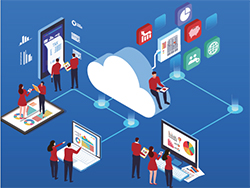 The pandemic has accelerated the need for digitalisation of payments, not least for fund and wealth administrators. Moves are now well under way, but challenges remain for all players – not least around culture, skills and fraud prevention
The pandemic has accelerated the need for digitalisation of payments, not least for fund and wealth administrators. Moves are now well under way, but challenges remain for all players – not least around culture, skills and fraud prevention
For some, the thought of a drive out into the country was a positive opportunity for much-needed respite from the toils and routines of the lockdown periods.
But to those for whom that drive was a business activity – trying to tie down a signature to make a fund transaction happen or racing to get documents signed so they could be delivered to a law firm the same day – it merely added to the pandemic stress.
The manual nature of many of the financial transactions and processes in the world of business and finance were exposed – as was the impact that they have on people’s ability to do business quickly and efficiently.
“We have heard some horror stories of administrators driving around the islands, collecting signatories on a payment and struggling to deliver payment instructions to banks, who were also working from home with branches closed. The payments sometimes couldn’t be made at all,” says David Elgie, Director at Jersey-based treasury and investment specialist JCAP.
“Those businesses that weren’t already using electronic signatories, such as DocuSign, had to quickly put these processes in place.”
As such, the pandemic has been a huge wake-up call to Jersey and Guernsey trust and fund administration companies when it comes to the crucial area of payments. It has driven an acceleration in the use of streamlined payments – faster and more automated.
And, given the huge growth in the sector in recent years, with several global businesses now headquartered in the Channel Islands, it’s a move that was certainly needed.
“Trust and fund administration companies on the islands are, collectively, making thousands and thousands of payments a day,” Elgie says. “It is a huge headache for these firms.
“If you work in a bank making payments, the process is relatively easy, because you are all plugged into the same network.
"But if you are working for a fund administrator or a trust company, you are the administrator for hundreds of different clients – all of which have multiple banking relationships. Sometimes it can be up to 50.”
Tearing up the manual
Elgie says the exposure of the industry’s shortcomings during the pandemic has enhanced awareness of the need for technology to streamline business operations more broadly, too, with the ultimate goal being to create a ‘global payments hub’ – centralising all payments and improving cash management across multiple banks and currencies.
 That’s a big step on from processes pre-Covid-19, when it was still common for administrators to have a drawer full of bank fobs that they would use to manually log on to online banking systems to make payments. Others still used physically signed payment instructions.
That’s a big step on from processes pre-Covid-19, when it was still common for administrators to have a drawer full of bank fobs that they would use to manually log on to online banking systems to make payments. Others still used physically signed payment instructions.
“A typical payments process involves a paper-based checklist, such as the mandate and signatories, and fraud and compliance checks – all completed manually by an administrator.
“Once that’s signed off, a payment is set up on one of the banking platforms. Then it is authorised into the banking platform, with a call back to check that beneficiary details are included.
“This process often crosses departmental lines – and often jurisdictions – and is so slow and inefficient,” Elgie explains.
The digitalisation of the payments process can eradicate all of that time and effort, he says. And a particularly important shift, which is central to real-time activity, will be the introduction of electronic bank statements.
“Connecting accounting software directly with multiple banks, who will deliver electronic statements, eradicates the need to interact with every single banking portal manually,” he says.
“This means that, once connected to the banks, you have the ability to have a centralised payment approval workflow and send payments directly to the banks without using banking portals and tokens at all. For businesses with multiple banks, this is an incredible efficiency drive.”
Ed Adshead-Grant, General Manager and Director, Payments, at Bottomline Technologies, agrees that the forced acceleration of digitalisation during the pandemic period has driven greater – and faster – use of digital payments processes, and less reliance on batch payments.
“People want real-time information today. They are bringing the consumer life of fast payments into the corporate life,” he says.
As well as delivering on client expectations and the convenience for fund administrators in general, he adds, it also gives treasurers the greater cash visibility, control and insights they crave to know their cash positions at all times.
Making it happen
Responsibility for implementing seismic changes to processes, particularly those involving payments, won’t sit solely with the banking institutions. There will also be requirements for firms – with changes needed to their internal processes, systems and technologies.
On the banking side, this digitalisation is well under way. Many of the larger banks now provide connectivity technology to connect their systems to firms’ systems, usually via Secure File Transfer Protocol (SFTP) or a file upload into their platform.
However, businesses with multiple banks and a high volume of payments are likely to choose to connect to their banks via the SWIFT network – a vast messaging network used by banks and other financial institutions to quickly, accurately and securely send and receive information – rather than having several individual connections to manage.
That will require firms to embrace some kind of ‘middleware’ – software that bridges gaps between applications. As Elgie explains: “There are numerous pieces of middleware technology available that offer daily visibility into all your bank accounts, provide a payment approval workflow and facilitate automated bank connectivity.
“The future is to look at middleware providers that allow companies to connect to their banks via SWIFT.”
However, picking the right provider will require research. “SWIFT can be complex, and each format can be different, based on whether you are sending payments to Citibank New York or RBSI Jersey, for example. You need a vendor who understands these complexities and how to get these formats right every single time,” Elgie says.
 Internal challenges
Internal challenges
Another challenge for firms will be managing changes to working culture and the new ways of doing things.
“People like to carry on doing things the way they always have. If you’re asked to approve a payment for £10m, you might previously have taken comfort from having a few pieces of paper to look through in your own time before committing to that payment,” Elgie says.
“Automating the process can get people a little bit worried. So firms need to help them realise that this will save them both time and cost.”
Adshead-Grant also raises the growing challenge and threat of authorised push payment (APP) fraud – where fraudsters take advantage of remote working and moves towards faster payments.
It is something companies need to be more aware of, he says, and that will require changes to practices, such as strengthening ‘confirmation of payee’ techniques and systems. “APP is when people are tricked and redirected to put payments across remotely on faster payment rails. They are irrevocable and gone within seconds,” he explains.
“It needs control. It needs more technical solutions and updated business practices to stop it – and to ensure people don’t lose trust in these automated systems.
“I know of one company that has started making a phone call to ensure a payment has gone to the right person and right company. I commend them – but this is the 2020s. More needs to be done.”
Pace of change
Despite all of these challenges, Elgie is confident that the move towards streamlined payments will continue at pace and quickly become an everyday practice across the sector.
“Payments will become a centralised function and there will be a centralised payments team,” he says. “Perhaps that team will be centralised in a lower-cost jurisdiction, too. If you have all of your banks plugged into one platform, you will be more efficient.”
Given the pain points exposed by the pandemic, a big driver for change has been speed and efficiency. But automated payments deliver other benefits, too.
Enhanced security is one – with people no longer swapping tokens with each other. Another is that it removes the over-reliance on passwords, which are often an entry point for cyber criminals.
Elgie says the software can also improve fraud detection, blocking unusual payments “made on a Saturday afternoon” or to an unusual jurisdiction.
“There is a pace of change that businesses need to digest, transform and modernise on,” says Adshead-Grant. “Otherwise, they will be left behind. Taking three or four days to settle is non-competitive. This is now a world of ‘instant’ and ‘real-time’. Even with huge payments, you can have security alongside the speed.
“Money is not going out of the door without any checks or balances. Technology can de-risk and quicken up the process,” Adshead-Grant adds.
Elgie agrees. “Pre-Covid, there were already plans to follow this route into automated payments, but it is a big project given the complexity of multiple banking relationships. So, it wasn’t top of the list then, but it is now.
“Everyone understands that we just can’t have a manual process anymore.”